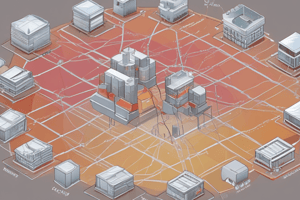Podcast
Questions and Answers
What is the primary function of the Transport layer in the OSI model?
What is the primary function of the Transport layer in the OSI model?
- Establishes and maintains communication between applications
- Handles packet routing and logical addressing
- Manages hardware connections and binary signals
- Ensures reliable delivery of data and provides flow control (correct)
Which layer of the OSI model is responsible for handling data representation and encryption/decryption?
Which layer of the OSI model is responsible for handling data representation and encryption/decryption?
- Presentation layer (correct)
- Application layer
- Network layer
- Session layer
Which device operates primarily at the Data Link layer of the OSI model?
Which device operates primarily at the Data Link layer of the OSI model?
- Computer
- Switch (correct)
- Router
- Firewall
What is the main responsibility of the Physical layer in the OSI model?
What is the main responsibility of the Physical layer in the OSI model?
Which of the following protocols operates at the Application layer of the OSI model?
Which of the following protocols operates at the Application layer of the OSI model?
What does the Session layer primarily accomplish in network communication?
What does the Session layer primarily accomplish in network communication?
Which type of addressing is provided by the Data Link layer?
Which type of addressing is provided by the Data Link layer?
At which layer of the OSI model would you find protocols like TCP and UDP?
At which layer of the OSI model would you find protocols like TCP and UDP?
Which OSI model layer is responsible for managing hardware connections and binary signals?
Which OSI model layer is responsible for managing hardware connections and binary signals?
What is the primary function of the Network layer in the OSI model?
What is the primary function of the Network layer in the OSI model?
Which of the following protocols operates at the Presentation layer?
Which of the following protocols operates at the Presentation layer?
What type of addressing is primarily associated with the Network layer of the OSI model?
What type of addressing is primarily associated with the Network layer of the OSI model?
What role do devices at the Data Link layer serve?
What role do devices at the Data Link layer serve?
Which OSI layer is responsible for establishing and maintaining communication sessions?
Which OSI layer is responsible for establishing and maintaining communication sessions?
How does the Transport layer ensure reliable data delivery?
How does the Transport layer ensure reliable data delivery?
Which protocols are associated with the Application layer of the OSI model?
Which protocols are associated with the Application layer of the OSI model?
Flashcards
OSI Model Layer 7
OSI Model Layer 7
The application layer in the OSI model manages programs accessing network resources.
Presentation Layer
Presentation Layer
The 6th layer handles data representation, conversions, and encryption/decryption, ensuring data compatibility between systems.
Session Layer
Session Layer
The 5th layer manages communication sessions between applications, establishing, maintaining, and terminating connections.
Transport Layer
Transport Layer
Signup and view all the flashcards
Network Layer
Network Layer
Signup and view all the flashcards
Data Link Layer
Data Link Layer
Signup and view all the flashcards
Physical Layer
Physical Layer
Signup and view all the flashcards
Network Configuration
Network Configuration
Signup and view all the flashcards
OSI Layer 7 Function
OSI Layer 7 Function
Signup and view all the flashcards
Presentation Layer Task
Presentation Layer Task
Signup and view all the flashcards
Session Layer Role
Session Layer Role
Signup and view all the flashcards
Transport Layer's Job
Transport Layer's Job
Signup and view all the flashcards
Network Layer's Goal
Network Layer's Goal
Signup and view all the flashcards
Data Link Layer Function
Data Link Layer Function
Signup and view all the flashcards
Physical Layer's Task
Physical Layer's Task
Signup and view all the flashcards
Network Configuration
Network Configuration
Signup and view all the flashcards
Study Notes
OSI Model Summary
- The OSI model categorizes network protocols and their functions.
- Network protocols may not strictly adhere to the model, but the model's concepts are still relevant.
- Understanding the OSI model is key to troubleshooting networks.
Table 9-7 Details
- Layer 7 (Application): Provides programs with access to network services. Uses protocols like HTTP, FTP, DHCP, DNS, SMB/CIFS, TFTP, and SMTP. Devices include computers.
- Layer 6 (Presentation): Handles data representation and conversions. Ensures data can be read by the receiving system, and handles encryption/decryption. Devices include Redirectors.
- Layer 5 (Session): Establishes, maintains, and coordinates communication between applications. Uses authentication protocols.
- Layer 4 (Transport): Ensures reliable delivery of data. Breaks data into segments, handles sequencing, acknowledgments, and provides flow control. Uses protocols like TCP and UDP.
- Layer 3 (Network): Handles packet routing, logical addressing, and access control for packet inspection. Devices include routers and layer 3 switches. Uses protocols like IP, ICMP, and ARP.
- Layer 2 (Data Link): Provides physical device addressing and delivery of frames. Handles media access control, and MAC addresses. Examples include Switches, NICs, and used Ethernet, token ring, and FDDI.
- Layer 1 (Physical): Manages hardware connections and handles encoding/decoding of binary signals. Examples are network media, hubs, repeaters, and connectors.
Network Configuration in an Operating System
- Network configuration in OS follows a similar pattern to network communication.
- All functions of the network model must be considered in configuration.
- Configuration begins with the physical aspects of the network.
Studying That Suits You
Use AI to generate personalized quizzes and flashcards to suit your learning preferences.




